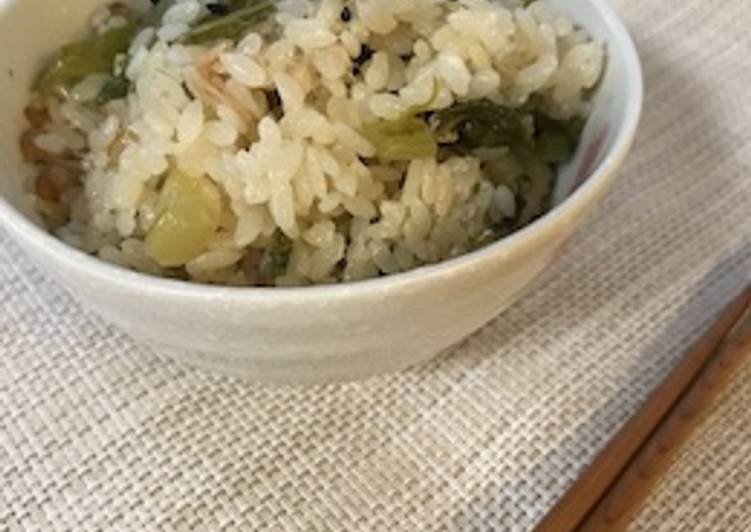Japanese Paella with Daikon Radish Leaves and Tuna (Takikomi Gohan). Buri Daikon is simmered Buri (yellowtail or amberjack) and Daikon (radish). It's a traditional and popular Japanese nimono (simmered food) cooked at home. I made a Japanese rice dish - Takikomi Gohan (Rice cooked with vegetables and fish/meat with Japanese style seasonings) with the leftover tuna I bought from.
 Cooking daikon takikomi gohan is not difficult.
Simply place daikon and aburaage on the rice with seasoned dashi stock and cook just like normal rice.
If the daikon comes with leaves, chop off the leaves just below where they start, then store it in the fridge.
Cooking daikon takikomi gohan is not difficult.
Simply place daikon and aburaage on the rice with seasoned dashi stock and cook just like normal rice.
If the daikon comes with leaves, chop off the leaves just below where they start, then store it in the fridge.
Hey everyone, it's Louise, welcome to my recipe page. Today, we're going to make a special dish, japanese paella with daikon radish leaves and tuna (takikomi gohan). It is one of my favorites food recipes. For mine, I'm gonna make it a little bit tasty. This is gonna smell and look delicious.
Buri Daikon is simmered Buri (yellowtail or amberjack) and Daikon (radish). It's a traditional and popular Japanese nimono (simmered food) cooked at home. I made a Japanese rice dish - Takikomi Gohan (Rice cooked with vegetables and fish/meat with Japanese style seasonings) with the leftover tuna I bought from.
Japanese Paella with Daikon Radish Leaves and Tuna (Takikomi Gohan) is one of the most popular of recent trending meals on earth. It's easy, it is quick, it tastes delicious. It's enjoyed by millions daily. They are fine and they look wonderful. Japanese Paella with Daikon Radish Leaves and Tuna (Takikomi Gohan) is something that I have loved my entire life.
To get started with this particular recipe, we must first prepare a few ingredients. You can have japanese paella with daikon radish leaves and tuna (takikomi gohan) using 9 ingredients and 6 steps. Here is how you can achieve it.
The ingredients needed to make Japanese Paella with Daikon Radish Leaves and Tuna (Takikomi Gohan):
- {Make ready 180 g of Daikon radish leaves.
- {Make ready 1 of Canned tuna.
- {Take 40 g of ginger.
- {Get 540 g of uncooked rice.
- {Prepare 480 mL of water (including soy sauce and Sake).
- {Prepare 10 cm of Kombu Kelp.
- {Prepare 2.5 tbsp of soy sauce.
- {Take 2 tbsp of Sake.
- {Get of roasted sesame seeds (for toppings).
It will keep longer without leaves attached. • Takikomi Gohan is seasoned steamed rice with meat and vegetables. Takikomi Gohan is great freshly cooked for dinner but also wonderful cold in Bento. By changing ingredients to canned Tuna, clams, or mushrooms, however, you can enjoy interesting and tasty variations. The Best Japanese Daikon Recipes on Yummly
Instructions to make Japanese Paella with Daikon Radish Leaves and Tuna (Takikomi Gohan):
- Rinse some rice..
- Cut ginger into thin strips. Cut Daikon radish leaves into small pieces..
- When the rice is soaked, put it in a pot with all liquids. Stir a few times..
- Put the Kombu kelp, Daikon radish leaves, ginger and canned tuna..
- Cook the rice. (Ref. How to cook Japanese rice https://goo.gl/yKkhpf).
- When the rice is cooked, mix it with a rice paddle. Serve in a bowl. Sprinkle the sesame seeds..
Mom's Daikon & Ninjin Sunomono (japanese Radish & Carrot Salad), Tuna Sashimi With Daikon And Ginger, Daikon, Carrot, Persimmon, And Pomegranate Sunomono. · Refreshing daikon salad with daikon (Japanese radish), mizuna, shiso leaf, with ponzu plum dressing. Garnish with Ikura (salmon roe). · Learn to make Japanese tuna sashimi with a dipping sauce and a light daikon salad. Always use sashimi or sushi-grade tuna for this recipe. Takikomi Gohan is Japanese mixed rice, seasoned with dashi, mirin, sake and soy sauce. As well, vegetables and some proteins get mixed in and cooked together which brings out additional flavours.
So that's going to wrap it up with this exceptional food japanese paella with daikon radish leaves and tuna (takikomi gohan) recipe. Thanks so much for reading. I'm confident that you can make this at home. There's gonna be more interesting food in home recipes coming up. Remember to bookmark this page in your browser, and share it to your family, colleague and friends. Thanks again for reading. Go on get cooking!